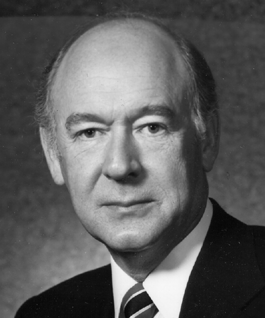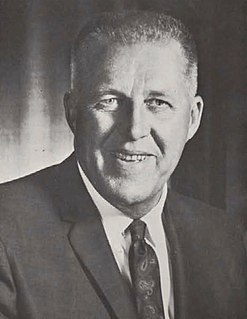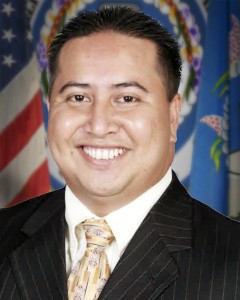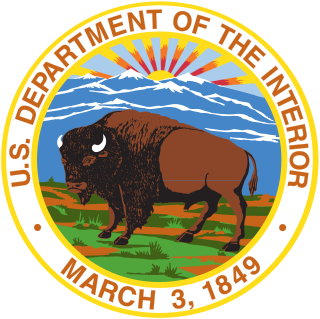
Clement Leroy "Butch" Otter is an American businessman and politician, who served as the 32nd governor of Idaho, from 2007 to 2019. A member of the Republican Party, he was elected in 2006, and reelected in 2010, and 2014. Otter served as lieutenant governor from 1987 to 2001 and in U.S. Congress from the first district from 2001 to 2007.

Cecil Dale Andrus was an American politician who served fourteen years as the Governor of Idaho. A Democrat, he also served as U.S. Secretary of the Interior from 1977 to 1981 during the Carter Administration. Andrus lost his first gubernatorial election in 1966, but won four and his 14 years as governor is the most in state history. Through 2019, he is the most recent Democrat to have held the office.

The 1986 United States Senate elections was an election for the United States Senate in the middle of Ronald Reagan's second presidential term. The Republicans had to defend an unusually large number of freshman Senate incumbents who had been elected on President Ronald Reagan's coattails in 1980. Democrats won a net of eight seats, defeating seven freshman incumbents and regaining control of the Senate for the first time since January 1981. The party not controlling the presidency gained seats, as usually occurs in mid-term elections.

The 1966 United States Senate elections was an election on November 8, 1966 for the United States Senate which occurred midway through the second term of President Lyndon B. Johnson. With divisions in the Democratic base over the Vietnam War, and with the traditional mid-term advantage of the party not holding the presidency, the Republicans took three Democratic seats. Despite Republican gains, the balance remained overwhelmingly in favor of the Democrats, who retained a 64–36 majority. This was also the first election that occurred after the Voting Rights Act of 1965 became law.

Donald William Samuelson was a Republican politician from Idaho. He was the state's 25th governor, serving a single term from 1967 to 1971, and is the state's most recent incumbent governor to lose a re-election bid (1970).

The 2006 Nebraska gubernatorial election was held on November 7, 2006; the primary election was held on May 9, 2006. Republican incumbent Dave Heineman was elected to a full term, defeating Democrat David Hahn.

United States gubernatorial elections were held Tuesday, November 4, 2008 in 11 states and two territories. Prior to the election, eight of the total seats were held by Democrats and five by Republicans. Two governors were prohibited by term limits from seeking re-election in 2008.

The Idaho Democratic Party is the affiliate of the Democratic Party in the state of Idaho. Although the party has been in the minority for most of the state's history, it has produced several notable public figures, including the late U.S. Senator Frank Church and former governor and Secretary of the Interior Cecil Andrus.
David H. "Dave" Leroy is a past Lieutenant Governor and Attorney General of Idaho.

United States gubernatorial elections were held on November 2, 2010 in 37 states and two territories. As in most midterm elections, the party controlling the White House lost ground. Democrats did take five governorships from the Republicans, and Republicans took 11 governorships from the Democrats. An independent won one governorship previously held by a Republican. A Republican won one governorship previously held by an independent. Republicans held a majority of governorships for the first time since before the 2006 elections. One state, Louisiana, had no election for governor, but did feature a special election for lieutenant governor.

The 1994 Idaho gubernatorial election was held on November 8, 1994 to select the governor of the U.S. state of Idaho. Cecil D. Andrus, the Democratic incumbent, chose not to seek reelection after a total of 14 years in office. Former state senator and Republican Party chair Phil Batt engineered a come-from-behind victory to defeat Democratic Attorney General Larry Echo Hawk. Batt's victory put the Idaho statehouse in Republican hands for the first time since 1970.

The 1990 Idaho gubernatorial election was held on November 6, 1990, to elect the Governor of the state of Idaho. Cecil D. Andrus, the Democratic incumbent, ran for an unprecedented fourth term. State Senator Roger Fairchild won the Republican nomination, but was easily defeated by the popular incumbent. As of 2019, this is the most recent election in which a Democrat was elected Governor of Idaho.
William J. Murphy was a Democratic politician from Idaho. He served as the state's 34th lieutenant governor from 1977 to 1979, during the administration of Governor John V. Evans.

The 2011 Kentucky gubernatorial election was held on November 8, 2011, to elect the governor of Kentucky and the lieutenant governor of Kentucky. Incumbent Democrat Steve Beshear won re-election, defeating Republican challenger David L. Williams, then the president of the state senate, and Gatewood Galbraith, an independent candidate. As of 2019, this is the most recent election in which a Democrat was elected Governor of Kentucky.

The 2014 Hawaii gubernatorial election took place on November 4, 2014, to elect the Governor of Hawaii, concurrently with a special election to Hawaii's Class III Senate Seat, as well as other elections to the United States Senate in other states and elections to the United States House of Representatives and various state and local elections.

The 2014 Idaho gubernatorial election was held on November 4, 2014, to elect the Governor of Idaho, concurrently with the election to Idaho's Class II U.S. Senate seat, as well as other elections to the United States Senate in other states and elections to the United States House of Representatives and various state and local elections.

United States gubernatorial elections were held on November 8, 2016 in 12 states and two territories. The last regular gubernatorial elections for nine of the 12 states took place in 2012. The last gubernatorial elections for New Hampshire, Oregon, and Vermont took place in 2014, as Oregon held a special election due to the resignation of governor John Kitzhaber, while the governors of New Hampshire and Vermont both serve two-year terms. The 2016 gubernatorial elections took place concurrently with several other federal, state, and local elections, including the presidential election, Senate, and House elections.

The 2018 Northern Mariana gubernatorial election took place on Tuesday, November 13, 2018, to elect the Governor of the Northern Mariana Islands and the Lieutenant Governor of the Northern Mariana Islands to a four-year term in office. The election, which corresponds to the larger Northern Mariana general election and the United States midterms, was originally scheduled to be held on Tuesday, November 6, 2018. However, Governor Ralph Torres postponed all elections in the territory until November 13 due to the impact of Typhoon Yutu, which struck the Northern Mariana Islands as a Category 5 storm in October 2018, shortly before the planned elections.

The 1970 Idaho gubernatorial election took place on November 3 to elect the Governor of Idaho. Incumbent Republican governor Don Samuelson sought re-election to a second consecutive term as governor. Although he faced a primary challenger, former state senator Dick Smith, he received more than 58 percent of the primary vote, and thus secured the party's re-nomination.
























